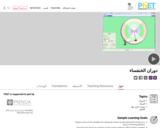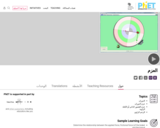
Identifying and applying transformations: translation, reflection, and rotation - Mathematics Instructional Plan
- Subject:
- Mathematics
- Material Type:
- Lesson Plan
- Provider:
- VDOE
- Author:
- VDOE
- Date Added:
- 10/07/2024

Identifying and applying transformations: translation, reflection, and rotation - Mathematics Instructional Plan

Just in Time Quick Check Transformations

Join the ladybug in an exploration of rotational motion. Rotate the merry-go-round to change its angle, or choose a constant angular velocity or angular acceleration. Explore how circular motion relates to the bug's x,y position, velocity, and acceleration using vectors or graphs.

Video Description: What causes the phases of the Moon? From New Moon to Full Moon, the Earth-Sun-Moon system is responsible for the Moon’s changing phases. Learn more about rotation, revolution and this repeatable pattern. Video Length: 3:13. NASA eClipsTM is a suite of online student-centered, standards-based resources that support instruction by increasing STEM literacy in formal and nonformal settings. These free digital and downloadable resources inform and engage students through NASA-inspired, real-world connections.NASA eClips Our World videos (grades 3-5) help students understand the differences between science (the natural world) and engineering (the designed world). These video segments supplement elementary learning objectives not only in science, technology, engineering and mathematics, but also in reading, writing, visual and performing arts.

Video Description: Find out more about how our sun's position in the sky changes due to Earth's rotation, revolution and tilt. Learn from the experts -- Dr. Alex Young and Dr. Nicki Viall explain these connections so students understand patterns within the Earth-sun relationship. Video Length: 2:19NASA eClips is a suite of online student-centered, standards-based resources that support instruction by increasing STEM literacy in formal and nonformal settings. These free digital and downloadable resources inform and engage students, through NASA-inspired, real-world connections.NASA eClips Our World videos (grades 3-5) help students understand the differences between science (the natural world) and engineering (the designed world). These video segments supplement elementary learning objectives not only in science, technology, engineering and mathematics, but also in reading, writing, visual and performing arts.

Find out more about how our sun's position in the sky changes due to Earth's rotation, revolution and tilt. Learn from the experts -- Dr. Alex Young and Dr. Nicki Viall explain these connections so students understand patterns within the Earth-sun relationship.

This lesson includes activites at all stages of the 5E model. When possible multiple options were provided at each stage. Cover Image: "Photo of the Earth taken from Apollo 8, called Earthrise (1968)." is licensed under CC0 by 1.0

Investigate how torque causes an object to rotate. Discover the relationships between angular acceleration, moment of inertia, angular momentum and torque.